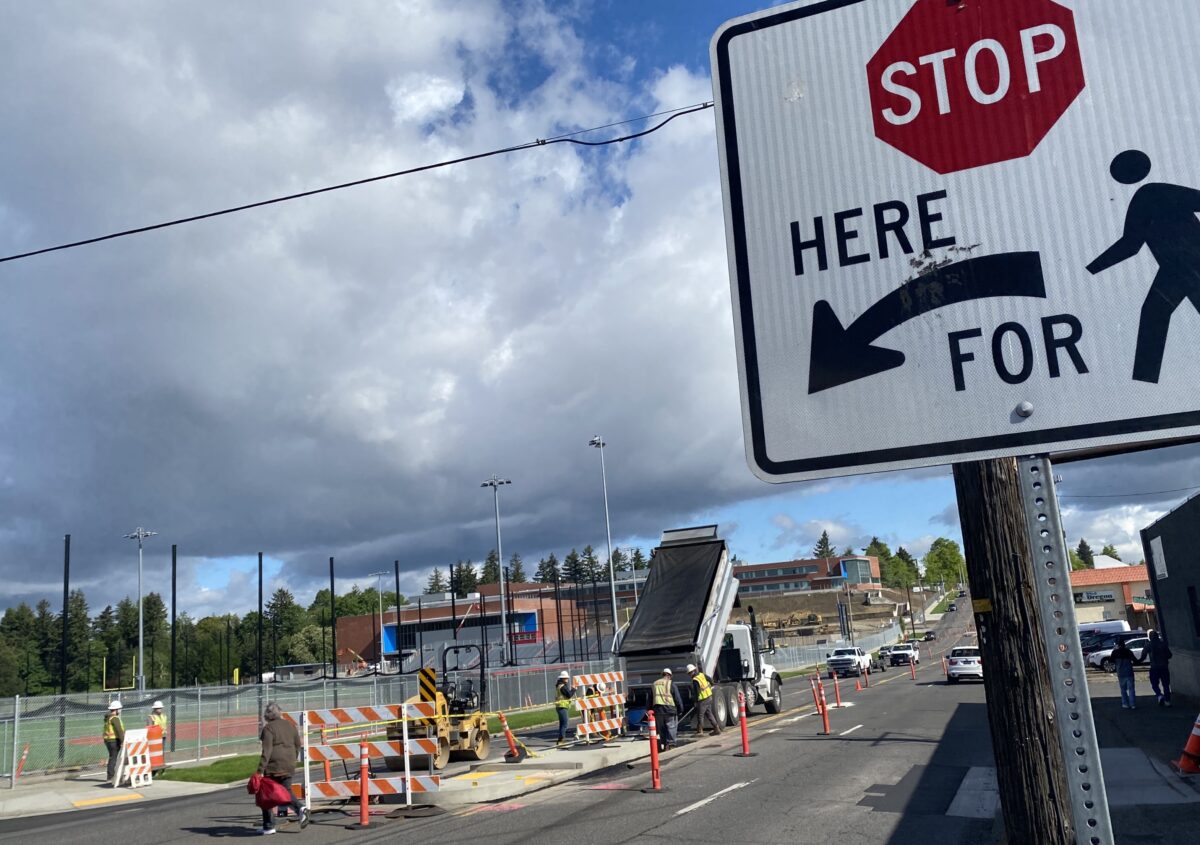
(Photos: Jonathan Maus/BikePortland)
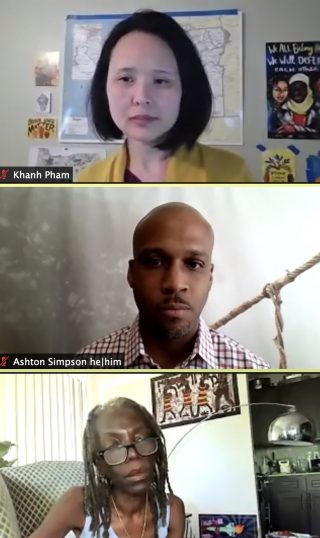
If the Oregon Department of Transportation hoped to alleviate pressure around their management of 82nd Avenue with the announcement of a $3.35 million investment, they were wrong. ODOT made the surprise announcement Friday just hours before a planned rally demanding safety upgrades to the notoriously deadly state highway.
In addition to the new funding, ODOT confirmed they would grant a City of Portland request to lower the speed limit from 35 to 30 mph — a request filed by the city nearly one year ago and only acted upon now because two people died at the same intersection within two weeks of each other last month.
“That announcement was no accident,” Portland Bureau of Transportation Commissioner Jo Ann Hardesty said during the rally (which was held online). “It happened because ODOT knew we were organizing, that we were going to put pressure on them, and that we were no longer going to allow the platitudes.”
Since the death of Anthony Tolliver and Stephen Looser at 82nd and Alberta, a broad coalition of advocates, community leaders and elected officials have come together to demand changes on 82nd. In addition to Hardesty, other speakers at the rally included Oregon State Representative Khanh Pham and State Senator Michael Dembrow.
“These streets should be connecting us, they should be bringing communities together — they shouldn’t be dividing us and they definitely shouldn’t be killing us.”
— Khanh Pham, Oregon state representative
Among these electeds and a host of nonprofit leaders at the rally, two themes emerged: A boiling-over of frustration at ODOT’s negligent stewardship of a road that has morphed in recent decades from highway to neighborhood street, and an agreement that the $3.35 million isn’t nearly enough to hasten its evolution from car-centric thoroughfare to a more people-centered place.
“Enough is enough!” said rally host Ashton Simpson, the leader of Oregon Walks and a resident of east Portland. “It is time to make one of the deadliest roads in our city finally worked for the community it literally cuts through.”
Advertisement

(Photo: Jonathan Maus/BikePortland)
Representative Pham is another leader with roots in east Portland. She lives just blocks away from 82nd and her young daughter crosses it every day on her way to school. On April 27th, Pham publicly called for “emergency and long-term interventions”. “This is just a downpayment,” Pham said at the rally. “I’m committed to making sure that we do everything we can.” As a local resident, Pham spoke to the mental impacts the street has. “The stress that comes from having to live next to these roads, it’s just too much,” she shared. She also touched on the lengthy struggle to have ODOT make significant changes on 82nd. “Community members are so jaded. We’ve been talking about this for years and they don’t see us taking action. They see the government saying platitudes, but not taking action. So I’m committed… these streets should be connecting us, they should be bringing communities together — they shouldn’t be dividing us and they definitely shouldn’t be killing us.”
Commissioner Hardesty is another local leader with both personal and professional connections to 82nd Avenue, a road she referred to as “the most unsafe street in the City of Portland to try and cross.” In her address to rally-goers, Hardesty said, “Automobile violence is really on the increase,” and that she and other elected leaders, “Have an obligation to address it using every tool we have.” Hardesty called ODOT’s $3.35 million a “drop in the bucket” and said Portland demands that the state cough up the $185 million to bring 82nd up to “good” condition so that it can be transferred from ODOT to PBOT ownership. “There’s no way we’re going to add to our $6 billion dollar maintenance backlog by taking on debt that the state should have been responsible for… We need ODOT to be a partner, and not a dictator of transportation systems in the City of Portland.”
Oregon Senator Michael Dembrow called 82nd Avenue a “wall between parts of Portland” that should be “a bridge between neighborhoods.”
Advocates used the rally to encourage everyone to take action and send a message to state legislators via this “Save 82nd Ave Now” online form. Oregon Walks also shared this handy “advocacy toolkit” to help keep the momentum going.
Advertisement
Thomas Ngo, a board member with The Street Trust, lives one block away from 82nd. He said ODOT can never claim to believe in transportation justice until they act more swiftly to remedy 82nd’s ills. “ODOT needs to put their dollars where their climate action and racial justice talk is. This is not about intention, it’s about outcomes.”
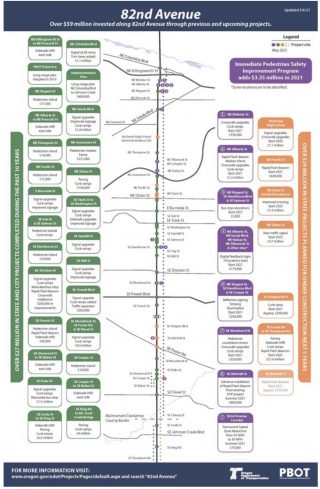
That comment is important, because it’s not as if ODOT hasn’t invested in 82nd. In the past decade ODOT (and PBOT) have spent $27 million to make it safer and they’ve got another $26 million on deck for the next five years.
In the short-term ODOT will ask their bosses on the Oregon Transportation Commission to authorize $10 million in funding for 82nd Avenue and other pedestrian safety projects on urban highways statewide. “These safety funds will allow ODOT to move promptly on improvements at several priority locations around the state where additional investments will make the most difference,” the agency said Friday.
ODOT has only released details of projects on 82nd. We expect to know more about other locations prior to the OTC meeting this Thursday (5/13).
In addition to the speed reduction on 82nd, ODOT says the $3.35 list of projects will include: new rapid flashing beacons at NE Pacific and SE Mitchell to be installed this summer; digital speed feedback signs “that increase driver awareness” at 10 locations; lighting, signage and striping upgrades at NE Wygant, SE Cooper and SE Hawthorne; and new crossings (with lighting, signs, and striping) at SE Mitchell, NE Webster and NE Alberta.
ODOT has also promised to hire an “independent reviewer” to assess all ODOT pedestrian safety programs, “with an eye toward delivering improvements more quickly on those roads with safety issue trends.”
ODOT says the projects on 82nd will be completed by fall of this year. For victims like Anthony Tolliver and Stephen Looser, it’s much too little, far too late.
— Jonathan Maus: (503) 706-8804, @jonathan_maus on Twitter and jonathan@bikeportland.org
— Get our headlines delivered to your inbox.
— Support this independent community media outlet with a one-time contribution or monthly subscription.



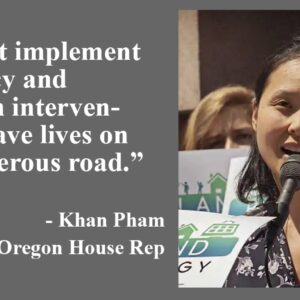

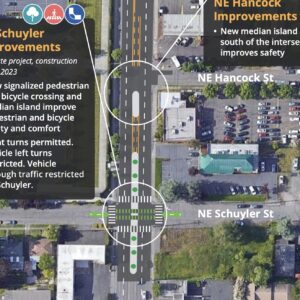
Thanks for reading.
BikePortland has served this community with independent community journalism since 2005. We rely on subscriptions from readers like you to survive. Your financial support is vital in keeping this valuable resource alive and well.
Please subscribe today to strengthen and expand our work.
On a per vehicle mile of travel basis (or some similar metric), is the killing of road users any worse on the ODOT system within Portland than it is on the streets under Portland control?
That’s a rather complex question. Aside from comparing traffic volumes and the origin/destination of drivers, the history of many streets in Portland is often of either the city or developers building roads which are later taken over by the state as federal or state routes, either as a designation or in terms of federal aid; or of state and county-built roads later being annexed by Portland and eventually handed over to the city (for example inner Sandy, parts of MLK, and Tom McCall Park.) I could be wrong, but I believe both inner Powell and 82nd were both originally built as city streets and later taken over by the state with the city’s blessing so that federal funds could be spent on both roads.
The traffic volumes on even Portland’s busiest streets such as outer Division are a small fraction of the daily volume on the Fremont Bridge or any interstate highway in the city. If you were to compare the lane-mile traffic of two similarly-designed streets in Portland, one city and the other state, you would very likely get similar volumes since there is only so much capacity. The design for both roadways is very likely to be almost exactly the same, since the city and county followed the lead of the state for several decades.
I think when we compared street deaths in 2020, there were far fewer deaths that were entirely on an ODOT facility versus those entirely on a city facility; but the vast majority of deaths occurred where city facilities intersected state facilities, so it’s nearly impossible to identify who ultimately is at fault for bad design. As at Alberta & 82nd, both jurisdictions are very negligent (sidewalks missing on one side of 82nd, none at all on Alberta, no safe crossings for either street, etc.) The city annexed the area west of 82nd in the 1950s, east of it in the 80s, so 40-70 years of negligence by the city. The state at least put in sidewalks on one side, but only in the last decade. While the state delayed lowering the speed limit request by the city for a whole year, it also took the city 70+ years to make the request.
From PBOT’s 82nd Ave. plan, “ODOT owns the sidewalks north of NE Prescott and south of SE Flavel. PBOT oversees sidewalk maintenance. Construction and maintenance of the sidewalk is the responsibility of the adjacent property owner, per City Code, Title 17, Chapter 17.28. Typically, sidewalk corridors are built and widened to City standards when private properties develop or redevelop.”
I think this illustrates the confusion of jurisdiction/responsibility. ODOT seems to own the sidewalk at this location. But who initiates an improvement? PBOT would “oversee” the work, but I don’t know if, barring an adjacent property renovation/permitted work, that PBOT could initiate an upgrade.
The phrase, “Typically, sidewalk corridors are built and widened to City standards when private properties develop or redevelop.” has a long and controversial history. For most of the 90s through about 2012 PBOT, BPS, and most neighborhood land use chairs translated as being not “typically” but as “always”, either through development or through liens as part of LIDs. However, a 2000 PBOT report documented conclusively that the city had a long history of building sidewalks at city taxpayer expense, usually at the instigation of politicians, but the report was basically suppressed by higher ranking officials worried about budgets. It wasn’t until 2012 that PBOT even admitted that they wrote such a report.
The sidewalks along outer Sandy beyond 122nd were built within the last decade by PBOT under contract for ODOT, so there exists some sort of legal mechanism for PBOT to build improvements on ODOT facilities.
Did PBOT instigate or request the Sandy sidewalk be built? What does that process look like? It seems like ODOT has ownership of the sidewalks to the north of Prescott along 82nd. They can subcontract both the work and the design to another agency (here PBOT), but are they the ones who decide it gets done, being the owners?
For that matter, how does a pedestrian crossing get installed? Does PBOT request it and ODOT approve? What are the impediments to making 82nd safer, from an approval standpoint, not necessarily a political, financial or design perspective (though these are obviously very important too).
The plan to rebuild Sandy was made in the 90s but was very gradually implemented by ODOT. As part of the East Portland In Motion of 2012, ODOT agreed to add more length of sidewalks along Sandy at the behest of neighborhoods, our 10 state legislators, and the East Portland Action Plan organization, but the funding came from the same source as 136th and for outer Powell, from the cancelled CRC. ODOT’s ability to add sidewalks is rather limited as they are better at building highways, so they voluntarily contracted out both the design and construction to PBOT, who as contractors are really quite good at it. It’s up to ODOT to identify the need, set the specs, and approve of any new improvement – PBOT can offer an opinion but ODOT is under no obligation to listen, and some of PBOT’s suggestions on outer Powell were in fact quite nasty. However on Sandy they were willing to work with each other, so it’s a case-by-case issue rather than a systematic issue.
For approval of pedestrian crossings nearly anywhere, in any state or jurisdiction, the issues typically include traffic speeds and volume plus liability – is a safe crossing (for the pedestrian) even possible without a full signal? How badly will it mess up car traffic and emergency response rates? If a pedestrian island is needed, are there sewer or water lines that need to be moved? Is there enough space in the roadway? Curb extensions are prohibitively expensive when sewers need to be moved, but small external curb islands aren’t so bad. Most jurisdictions also require traffic studies and pedestrian counts – it looks really bad when an agency puts in an improvement and no one uses it.
The statistic I’d like to see is the opposite–not deaths relative to vehicle miles, but deaths relative to amount of pedestrian and bike use. I’d guess most ODOT roads in Portland would come out badly, but PBOT roads that have similar vehicle traffic might not be any better. In other words, any street in Portland with lots of vehicle traffic and not a lot of people walking or biking would have a poor death-per-mile-walked statistic.
Then those busy street (both ODOT and PBOT) statistics could be compared to streets where there are lots of people biking and walking. The comparison would show that, per pedestrian mile walked, someone walking on Powell, for instance, is 10x or 20x (or whatever) more likely to be killed than someone walking on SW Broadway, and maybe 100x (or whatever) more likely than someone walking on say, SW Vista.
Then put it all on a map, which would (I’m guessing) be further evidence of how much less safe you are walking a mile in outer East Portland vs. other parts of the city.
Your suggestion is equally good. It seems that the decisions (and ODOT bashing) are not being made on any analysis, just a series of possibly wrong assumptions. Many people convinced that redesign of streets will easily and quickly solve the problem though costs will be huge and the unintended consequences (like cut through traffic on neighborhood streets) are ignored or, at least, underestimated.
I am as upset as anyone with the behavior of most motorists and blatant disregard they have for other road users. I think one look no further than the almost complete absence of traffic enforcement and the lack of meaningful consequences for scofflaw motorists to understand why road user deaths are skyrocketing in Portland.
I think there is something fundamentally different about centering the analysis of traffic deaths on pedestrian and other vulnerable road users vs vehicle through-put. For 100 years we have prioritized the car and convince of people who drive to the detriment of not only other road users but the very communities that high speed highways/roads pass though. I’d like to see 82nd redesigned in such a way that it promotes safer driving behavior rather than relying on the better behavior/judgment to drivers, which I have very little confidence in. We invest so little in driver training, require so little of people who drive, then blame “bad apples” for making urban highways unsafe.
I don’t think the analysis can ignore the avoided use of the road. How many people won’t walk along or cross 82nd because the design is so dangerous (real or perceived)? If those people used the street, there might be many more deaths. qqq’s metric would seem better to reflect this. Yours would show great results if lots of cars drive but very few people walking or rolling used the street (and thus very few were killed).
Those digital feedback signs DO NOT contribute to a safer pedestrian environment. The Road itself needs to be made safer: narrow lanes, wider sidewalk, generous plant strip with large trees, curb extensions, pedestrian-scaled lighting, slower speeds, on-street parking. Digital feedback are highway signs and are 100% inappropriate for a Main Street. Look a the transformation of SE Division between Cesar Chavez through street into a Main Street that was focused on creating spaces for people on the sidewalks, easy crossing, vegetated storm water planters and street trees and public art. That is the vision I would want to see for 82nd. Forget about through-put and capacity. Add parking and bus lanes with bustop curb extensions, move the power lines to the east side of the street and create wide sidewalks with 5′-6′ planting strips with big trees. Find opportunities for mini plazas. Main Street, not stroad and no digital feedback signs- design this place for everyone NOT in a car, then make the car conform.
I’ve always wondered about the digital feedback signs – the ones that tell you how fast you are going as you approach them. Some wag here once said, “You already have digital feedback: look at your speedometer.”
While cycling near these signs, I’ve noticed that many drivers just ignore them, since there are no consequences. The signs remind me of something a friend told me about the lock on the front door of his house: “It keeps out the honest people.” Likewise these signs help the drivers who WANT to obey the law but no one else.
Just a side comment not directly related to the very important message of this article, but regarding the photo caption, the official name of the former Madison HS (named for the 4th president, who was a slaveholder) is now McDaniel HS, named for pioneering African American Portland school administrator Leodis V. McDaniel.
https://katu.com/news/local/madison-high-school-to-be-renamed-leodis-v-mcdaniel-high-school#:~:text=%E2%80%94%20The%20Portland%20Public%20Schools%20Board,McDaniel%20High%20School.&text=The%20new%20name%20will%20honor,in%20the%201970s%20and%2080s.
Thanks Michael! I didn’t know that and I will edit the caption ASAP.
Michael,
San Francisco is a bit ahead of us on the school renaming issue.
https://www.nytimes.com/2021/04/07/us/san-francisco-schools-names.html
That article indicates SF is *not* renaming all the schools and fleecing the public for the costs, which I applaud.
Great to see. Though some of those elected officials (at least Sen. Dembrow and Lynn Peterson) have been big supporters of spending hundreds of millions of dollars on things like the Columbia River Crossing (and I believe they’re supportive of the I-5 Rose Quarter project, but not sure), meaning those dollars haven’t gone (and aren’t likely to go) to making truly dangerous roadways safe.
Reminds me of the Eisenhower quote:
“Every gun that is made, every warship launched, every rocket fired signifies, in the final sense, a theft from those who hunger and are not fed, those who are cold and are not clothed.”
Applied here, every huge urban highway expanded signifies, in the final sense, a theft from those who desire safety but are not protected, those who want choices but have none.
When CRC version 1.0 was cancelled, we pointed out to our local legislator that $27 million/year in bond payments for 30 years was the amount that ODOT set aside to build it and we suggested that our 10 East Portland legislators ought to grab all they could as quickly as possible to fund local projects. They did so and we promptly got lots of pedestrian islands, 136th paved and sidewalked, and now outer Powell funded with about the first 6 years of payments. No doubt the other 24 years they’ll use for version 2.0
Well, I hope the ODOT can come up with some big money! I do wish Hardesty would focus a bit more on PBOT and less on ODOT. Plenty of improvement needed at PBOT regarding traffic violence against residents and visitors of Portland.
(Jonathan consider posting this instead of censoring a criticism of your favorite council member 🙂 )
Thanks for the comment Ernie R.
To clarify: I never censor criticism if it is done with respect and tact (like this one!). Also, I don’t have “favorite” council members.
I like Joanne Hardesty a lot and I also think Ernie’s comment is totally reasonable. As JM says, good comments that take opposing positions do get posted.
If you see the blog mentioning Hardesty a lot, it’s because she’s the PBOT commissioner. If PBOT had stayed with the seat formerly held by Chloe Eudaly, I’m sure the blog would be mentioning Mingus Mapps a lot.
She seems to me quite focused on PBOT. I don’t think also taking an interest in 82nd detracts from that. Besides, she’s advocating that 82nd be upgraded and transferred to PBOT, so it’s literally part of the job.